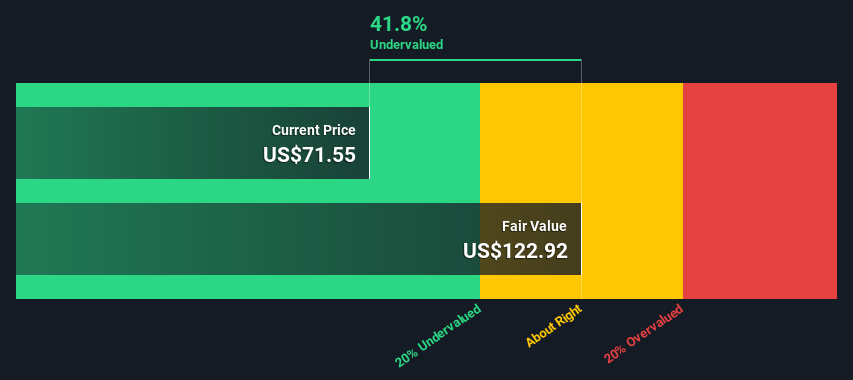- United States
- /
- Retail REITs
- /
- NYSE:O
Realty Income Corporation (NYSE:O) Looks Undervalued and is Yet to Recoup 2020 Losses

Realty Income Corporation ( NYSE:O ) is easily one of the most popular monthly dividend payers around. Providing an excellent record of growing monthly payments, this stock has yet to recoup its 2020 losses.
In this article, we will review Realty Income's intrinsic value through a Discounted Cash Flow (DCF) model.
We would caution that there are many ways of valuing a company, and, like the DCF, each technique has advantages and disadvantages in certain scenarios. If you still have any questions about this type of valuation, look at the Simply Wall St analysis model .
Going Ex-Dividend
With a declared US$0.2355 monthly dividend, this currently translates into a forward yield of 3.91%. The dividend is payable September 15, and going ex-dividend tomorrow, August 31.
Furthermore, the company just received shareholder's approval for a merger with VEREIT. The merger is expected to finalize during Q4 2021.
View our latest analysis for Realty Income
DCF Model
We're using the 2-stage growth model, which means we take two stages of the company's growth. In the initial period, the company may have a higher growth rate, and the second stage is usually assumed to have a stable growth rate.
To begin with, we have to get estimates of the next ten years of cash flows.Where possible, we use analyst estimates, but when these aren't available, we extrapolate the previous free cash flow (FCF) from the last estimate or reported value. We assume companies with shrinking free cash flow will slow their rate of shrinkage and that companies with growing free cash flow will see their growth rate slow over this period. We do this to reflect that growth tends to slow more in the early years than in later years.
A DCF is all about the idea that a dollar in the future is less valuable than a dollar today,so we discount the value of these future cash flows to their estimated value in today's dollars:
10-year free cash flow (FCF) estimate
| 2022 | 2023 | 2024 | 2025 | 2026 | 2027 | 2028 | 2029 | 2030 | 2031 | |
| Levered FCF ($, Millions) | US$1.52b | US$1.72b | US$1.88b | US$2.02b | US$2.13b | US$2.22b | US$2.31b | US$2.38b | US$2.45b | US$2.51b |
| Growth Rate Estimate Source | Analyst x6 | Analyst x3 | Est @ 9.28% | Est @ 7.09% | Est @ 5.56% | Est @ 4.49% | Est @ 3.74% | Est @ 3.22% | Est @ 2.85% | Est @ 2.59% |
| Present Value ($, Millions) Discounted @ 6.2% | US$1.4k | US$1.5k | US$1.6k | US$1.6k | US$1.6k | US$1.5k | US$1.5k | US$1.5k | US$1.4k | US$1.4k |
("Est" = FCF growth rate estimated by Simply Wall St)
Present Value of 10-year Cash Flow (PVCF) = US$15b
We now need to calculate the Terminal Value, which accounts for all the future cash flows after this ten-year period.The Gordon Growth formula is used to calculate Terminal Value at a future annual growth rate equal to the 5-year average of the 10-year government bond yield of 2.0%. We discount the terminal cash flows to today's value at the cost of equity of 6.2%.
Terminal Value (TV) = FCF 2031 × (1 + g) ÷ (r - g) = US$2.5b× (1 + 2.0%) ÷ (6.2% - 2.0%) = US$60b
Present Value of Terminal Value (PVTV) = TV / (1 + r) 10 = US$60b÷ ( 1 + 6.2%) 10 = US$33b
The total value is the sum of cash flows for the next ten years plus the discounted terminal value, which results in the Total Equity Value,which in this case is US$48b.
To get the intrinsic value per share, we divide this by the total number of shares outstanding.Compared to the current share price of US$71.6, the company appears quite undervalued at a 42% discount to where the stock price trades currently.
Valuations are imprecise instruments, do keep this in mind.

Important Assumptions
The calculation above is very dependent on two assumptions. The first is the discount rate, and the other is the cash flows.
Part of investing is coming up with your own evaluation of a company's future performance, so try the calculation yourself and check your own assumptions.The DCF also does not consider the possible cyclicality of an industry or a company's future capital requirements, so it does not give a full picture of a company's potential performance.
Given that we are looking at Realty Income as potential shareholders, the cost of equity is used as the discount rate rather than the cost of capital (or the weighted average cost of capital, WACC), which accounts for debt.We've used 6.2% in this calculation, which is based on a levered beta of 0.900. Beta is a measure of a stock's volatility compared to the market as a whole. We get our beta from the industry average beta of globally comparable companies, with an imposed limit between 0.8 and 2.0, a reasonable range for a stable business.
Moving On:
Whilst important, the DCF calculation shouldn't be the only metric you look at when researching a company.DCF models are not the be-all and end-all of investment valuation.Preferably you'd apply different cases and assumptions and see how they would impact the company's valuation.If a company grows at a different rate, or if its cost of equity or risk-free rate changes sharply, the output can look very different.What is the reason for the share price sitting below the intrinsic value?For Realty Income, there are three pertinent factors you should further research:
- Risks : To that end, you should learn about the 5 warning signs we've spotted with Realty Income (including 1, which makes us a bit uncomfortable) .
- Future Earnings : How does O's growth rate compare to its peers and the wider market? Dig deeper into the analyst consensus number for the upcoming years by interacting with our free analyst growth expectation chart .
- Other High-Quality Alternatives : Do you like a good all-rounder? Explore our interactive list of high-quality stocks to get an idea of what else is out there you may be missing!
PS. The Simply Wall St app conducts a discounted cash flow valuation for every stock on the NYSE every day. If you want to find the calculation for other stocks, search here .
New: AI Stock Screener & Alerts
Our new AI Stock Screener scans the market every day to uncover opportunities.
• Dividend Powerhouses (3%+ Yield)
• Undervalued Small Caps with Insider Buying
• High growth Tech and AI Companies
Or build your own from over 50 metrics.
Have feedback on this article? Concerned about the content? Get in touch with us directly. Alternatively, email editorial-team@simplywallst.com
Simply Wall St analyst Stjepan Kalinic and Simply Wall St have no position in any of the companies mentioned. This article is general in nature. We provide commentary based on historical data and analyst forecasts only using an unbiased methodology and our articles are not intended to be financial advice. It does not constitute a recommendation to buy or sell any stock and does not take account of your objectives, or your financial situation. We aim to bring you long-term focused analysis driven by fundamental data. Note that our analysis may not factor in the latest price-sensitive company announcements or qualitative material.

Stjepan Kalinic
Stjepan is a writer and an analyst covering equity markets. As a former multi-asset analyst, he prefers to look beyond the surface and uncover ideas that might not be on retail investors' radar. You can find his research all over the internet, including Simply Wall St News, Yahoo Finance, Benzinga, Vincent, and Barron's.
About NYSE:O
Realty Income
Realty Income (NYSE: O), an S&P 500 company, is real estate partner to the world's leading companies.
6 star dividend payer low.

